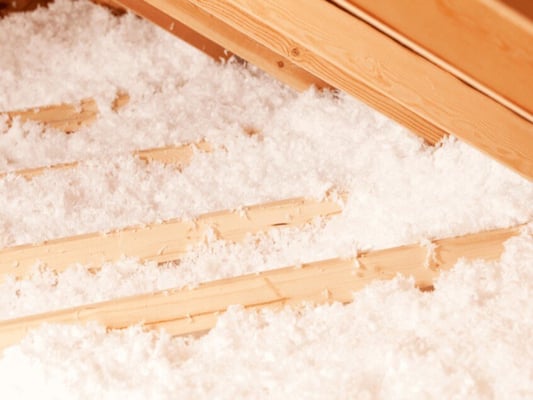One of the biggest concerns for homeowners is the cost of home improvement projects. Can you afford to upgrade your attic insulation? What would it cost for you to change your attic insulation to blown-in with an airtight seal?
South Central Services has insulated hundreds of new and existing homes around Carlisle and Mechanicsburg, PA. We pride ourselves on our transparent pricing and making estimate tools more accessible.
By the end of this article, you will understand:
- What factors impact the cost of blown-in insulation
- How much blown-in attic insulation costs
Don't have time to read right now? Check out everything you need to know at a glance.
Blown-In Prices For Attics Vary Based On A Few Factors.
 There is not a universal price for blown-in insulation. One of the simplest reasons blown-in does not have a consistent price is R-value. Every climate zone has a different ideal R-value for attics. In our climate zone, Climate Zone 5, attics need an R-value of about R-49.
There is not a universal price for blown-in insulation. One of the simplest reasons blown-in does not have a consistent price is R-value. Every climate zone has a different ideal R-value for attics. In our climate zone, Climate Zone 5, attics need an R-value of about R-49.
A lower R-value means less expensive insulation. As R-value goes up, so does the price. However, there are other factors that influence the cost of blown-in insulations. These factors include:
- Type of blown-in
- Size of attic
- Optional air-seal upgrade
Let’s examine each of these factors in more detail.
1. Blown-In Cellulose Is Less Expensive Than Blown-In Fiberglass.
Blown-in is a general term that refers to both blown-in cellulose and blown-in fiberglass. Which type of blown-in you are researching will impact the price.
Blown-in prices are constantly fluctuating. Sometimes, one type of blown-in insulation is significantly more expensive than the other. Other times, the two types are nearly neck-and-neck in pricing.
In recent history, blown-in cellulose tends to be less expensive than blown-in fiberglass by a decent margin.
2. Larger Attics Are More Expensive To Insulate, Even With Blown-In.
This factor may seem obvious, but it needs to be stated. Larger attics need more materials, so the overall cost to insulate goes up.
In our service area, a small attic floor is under 750 square feet. Average attics range between 750 and 2,000 square feet. Anything more expansive than 2,000 square feet, we consider to be a larger attic floor.
3. Adding An Airtight Seal Makes Blown-In More Efficient–And Expensive.
.jpg?width=338&height=450&name=7.30.24%20Blown-in%20prep%20(T).jpg) Blown-in insulation on its own can combat conductive heat transfer. However, it is very limited against heat transfer that uses air. Convection and radiation both transfer heat through air movement. When attics have air leaks, they also allow heat to leak.
Blown-in insulation on its own can combat conductive heat transfer. However, it is very limited against heat transfer that uses air. Convection and radiation both transfer heat through air movement. When attics have air leaks, they also allow heat to leak.
We always recommend an airtight seal when working with blown-in insulations. By installing an air-seal on the floor, blown-in insulation can also slow convective and radiant heat. Stopping air leakage means a more comfortable home and lower energy bills.
Adding an air-seal isn't free, though. While you will recoup that investment over time through lower energy costs, an attic with an air-seal and blown-in is more expensive than blown-in alone.
Let’s Calculate Some Sample Estimates For Attic Blown-In.
In the following sections, we'll examine estimates for two types of blown-in: fiberglass and cellulose paired with an air-seal. You can use the price ranges we present to estimate the cost of these insulations for your attic. As long as you know the square footage of your attic floor, you can walk away with some ballpark estimates.
Sample Estimate For Blown-In Fiberglass Insulation
We do not install blown-in fiberglass at South Central Services. We have invested in a blown-in truck that exclusively installed cellulose. However, we can help you estimate the cost of fiberglass for your attic floor.

Let's assume the attic floor is 1,000 square feet, which is an average attic in Greencastle, PA. If the attic floor is 1,000 square feet, how much would it cost to install R-49 and R-60?
At R-49, blown-in fiberglass could cost anywhere between $2.50 and $4.00. For 1,000 square feet, blown-in fiberglass would cost between $2,500 and $4,000.
At R-60, blown-in fiberglass would cost closer to $3.00 and $5.00. For 1,000 square feet, blown-in fiberglass would cost between $3,000 and $5,000.
Without an air-seal, cellulose costs between $1.70 and $3.00, depending on the R-value. Our team charges between $1.50 and $4 for blown-in cellulose with an airtight seal.
Without an airtight seal, most blown-in products should not cost more than $3.50 per square foot. The addition of an air-seal can raise the price as high as $4 per square foot.
Now that you understand how to calculate the price of blown-in insulation for your attic, your next step is to:
Alexis Dingeldein
Alexis has been fascinated by spray foam insulation since 2018. When she isn’t thinking about insulation, Alexis is geeking out over storytelling and spreadsheets.
 When we install blown-in cellulose in an attic, we always pair it with an air-seal. The addition of the air-seal raises the cost per square foot.
When we install blown-in cellulose in an attic, we always pair it with an air-seal. The addition of the air-seal raises the cost per square foot.


 There is not a universal price for blown-in insulation.
There is not a universal price for blown-in insulation. .jpg?width=338&height=450&name=7.30.24%20Blown-in%20prep%20(T).jpg) Blown-in insulation on its own can combat conductive heat transfer. However, it is very limited against heat transfer that uses air.
Blown-in insulation on its own can combat conductive heat transfer. However, it is very limited against heat transfer that uses air. 

